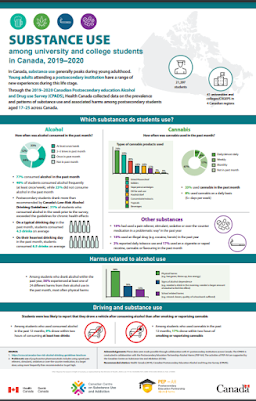In recent weeks three new reports have been issued which shed more light on the tobacco and nicotine use of Canadians.
Some of this newly-released data shows youth vaping in Canada remained high in 2020. Others show that over the past 3 decades, Canada has done better than most other countries at reducing cigarette smoking.
1. The Canadian Postsecondary Education Alcohol and Drug Use Survey (CPADS)
The first wave of Health Canada's new survey of post-secondary student drug use was released in May. Over 20,000 students aged between 17 and 25 attending 41 universities, colleges and CEGEPs participated in this survey in the fall of 2019 and the spring of 2020.The survey found that one in ten (10%) of the students surveyed had smoked cigarettes in the past month, and almost one in five (17%) had used vaping products (either for nicotine, cannabis or other products). A larger number - 24% - appeared to have smoked cannabis in the past month, that they reported using dried cannabis flowers or leaves, and a smaller portion - 4% - reported smoking other forms of tobacco, such as pipes, cigars or shisha.
In terms of daily use, roughly the same number used cannabis (8%) or vaping/e-cigarette use (7%). Daily cigarette smoking was 2%.
By way of comparison, in 2017-2018, the Canadian Community Health Survey (CCHS) reported that among students aged 18 to 24, current smoking was about 13% (4.5% daily and 8.3% occasional). The CCHS did not ask questions about vaping across Canada until this year.
A second wave of the Canadian Tobacco and Nicotine Survey (CTNS) of the general population conducted in the fall-winter of 2020-2021 estimated that 13% of young adults (aged 20-24) had vaped in the past month, as had 14% of teenagers (aged 15-19). A much smaller proportion of the CTNS survey respondents had reported vaping daily in comparison with the CPADS (2% vs. 7%).
Differences in survey methods (including questoinnaires) may have accounted for the Survey questionnaires for the CPADS were not included in the data release.
2. The Québec Survey on Tobacco and Vaping Products (QSTVP)This work was funded by the Bloomberg Foundation, and continues and expands the data gathering efforts that were previously housed within the World Bank and the World Health Organization. It complements their release last year of estimates of deaths and life years lost attributable to various diseases and causes. (This report is the basis of the estimate that 50,700 Canadian deaths are attributable to tobacco use.)
Canada has been more successful than most at reducing smoking over the past 30 years.
The good news is that around the world, smoking prevalence fell by more than one-quarter (-29.6%) between 1990 and 2019. The better news for Canadians is that here smoking prevalence fell by almost half (-47%). Among the 204 countries surveyed, Canada ranked ninth for reductions in age-adjusted smoking prevalence over this period. The leader was Brazil, where smoking prevalence fell by three-quarters (074%).
This data compilation shows that progress (and lack of progress) was found in all regions and at all national income levels. Costa Rica and Colombia did better than Sweden and New Zealand, Mexico came ahead of the United States and Germany and France did even worse than China.
The researchers counted anyone who used combustible tobacco on a daily or occasional basis as a smoker. This is different than other global rankings which compare daily smokers only, and allows a better comparison with countries where poly-tobacco use can result in a smaller proportion of smokers being daily cigarette smokers.
In Canada, the early 2000s were years of faster progress
As shown in the graph below, the IMHE data suggests that the fastest deceleration of age-adjusted smoking rates in Canada, especially for women, was between the mid 1990s and mid 2000s. Notably, these were the years when promotional restrictions, smoking bans, graphic health warnings and tax increases were being implemented by governments across Canada.
Canada is keeping up with some, but not all, leading countries.
Canada's current rates are lower othan those in two other countries which have set endgame goals: New Zealand aims to reduce smoking to 5% by 2025, and Finland aims to reduce tobacco and nicotine use to 5% by 2030.
Tobacco smoking in Canada is higher than in Sweden (although the gap has mostly been closed for women and has somewhat been closed for men).
Canada is doing worse than Brazil, where smoking rates were about the same in 1990 and are now about half as high. In 2019, WHO identified Brazil as one of two countries to have adopted the MPOWER suite of tobacco control measures at a "high level".





